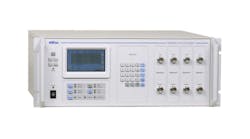While numerous conversations on the EDI CON 2016 exhibition floor turned to the growing needs for broadband communications, at least one exhibit revealed solutions for handling measurements with increased bandwidth.
The model SLE900 Satellite Link Emulator from dBm Corp. also follows a trend in designing test equipment in a modular fashion for feature flexibility. The signal source is geared for testing satellite-communications (satcom) system testing and can be configured with 1, 2, 3, or 4 independent channels and with center frequencies of 70 and 140 MHz with 72-MHz bandwidth, 140 MHz with 125-MHz bandwidth, and 1200 MHz with 250-MHz bandwidth, for emulating the link signal conditions of different satcom systems.
On display and demonstration at EDI CON 2016 Booth #713, the link emulator provides as many as six taps per channel. The instrument uses those wide-bandwidth signal channels to provide sitcom-like signals for testing, with link impairments that include delays, Doppler shifts, attenuation/loss, phase errors, multipath distortion, and additive white Gaussian noise (AWGN). The instrument can be used in different modes, such as static mode where the link impairments are set to fixed values, and dynamic mode where data files can be loaded from an Ethernet connection for changing conditions of link signals.
As much as 1400 ms delay can be added per channel, depending upon model, with typical noise floor of -141 dBm/Hz. Signal attenuation can be set from 0 to 70 dB with 0.1-dB resolution. The phase offset range is 0 to 180 deg., adjustable with 1-deg. resolution. The link emulators feature excellent frequency accuracy, thanks to a 10-MHz internal frequency reference. They can be remotely controlled via test software of choice of the firm’s SleControl software provided with each instrument.

